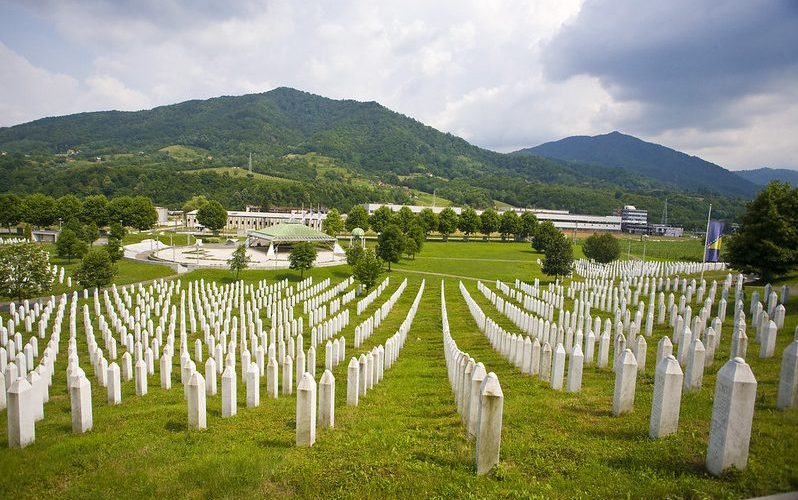This is an excerpt from the author’s forthcoming article “Violation of international humanitarian law in Bosnia and Herzegovina”.
Only a few decades after the genocide of World War II, the international community largely failed in its role as an intermediary in the war that followed the breakup of Yugoslavia. On the doorstep of the 21st century, new genocidal tendencies appeared in Europe. The ethnic cleansing in Srebrenica, Prijedor, Foca, Bratunac, Sarajevo, as well as all the occupied places and cities under siege in the Republic of Bosnia and Herzegovina, came just a few decades after the Holocaust. The terrible events and the civilian population’s circumstances in Srebrenica during the military conflict left a black shadow on European history. According to the International Committee of the Red Cross, 8372 Bosnian Muslims were killed in Srebrenica between July 12 and 16, 1995, in what turned out to be the worst genocide in modern Balkan history.
The end of “Brotherhood and Unity”
The war in Bosnia and Herzegovina is closely related to the breakup of Yugoslavia. The Yugoslav crisis began with the weakening of the communist government and its structures, rendering the famous “brotherhood and unity” between the people fragile. Proportionally, with the debilitating communist power and unity, the first separatist movements and ideologies began to appear towards the end of 1988, first in Serbia and Croatia, later in Bosnia and Slovenia, and finally in Macedonia.
The former Ottoman province, today’s Bosnia and Herzegovina, has historically been a multi-ethnic state. At the 1991 census, 44% of the population declared themselves Muslims Bosniaks, 32% Orthodox Serbs, and 17% Catholic Croats. On February 29 and March 1, a referendum on the independence of Bosnia and Herzegovina was held. The Serbs opposed this move and declared their own state within Bosnia and Herzegovina, known as the Republic of Srpska. The first riots broke out during and after the referendum, escalating into a total war in the beginning of April 1991, when the international community officially recognized Bosnian independence.
The rise of the genocidal dawn
Srebrenica, located on the very border between Serbia and Bosnia and Herzegovina, was an easy target for the Serbian side once the war broke out. During the capture of Srebrenica (April 18, 1992) and after the occupation, a large number of Bosnian civilians were killed, slaughtered and burned, and a large number of houses and other civilian buildings were totally destroyed. In Srebrenica, in the spring and summer of 1992, there was an influx of a large number of exiled Bosniaks from neighboring municipalities. The number of residents of Srebrenica was growing day by day.
From the very beginning of the conflicts, both the Serbian military and paramilitary formations did not attach any importance to International Humanitarian Law so that already during the war, the people in Srebrenica were marginalized. The suffering of the Muslim population in the vicinity of Srebrenica worsened significantly in 1993, when the Serbian army began to disrupt the flow of food, and medicine to the besieged citizens. As a result of the military actions, the lack of food and the complete absence of medical care, dozens of citizens were dying daily.
In April 1993, the Serbian army shelled the football field in Srebrenica, killing 70 civilians and injuring more than 100. As a result, the UN Security Council, just days later, declared Srebrenica and its surroundings a “safe zone” that must not be attacked or exposed to any hostile acts by any of the sides included in the conflict, which led to even more and more arrivals of new refugees.
With the very declaration of the “safe zone”, the United Nations undertook a process to demilitarize the entire area of Srebrenica, but to great regret and injustice, only members of the Bosnian army and civilians were demilitarized, thus laying the ground for the organization of ethnic cleansing.
The genocidal campaign officially began on July 11, 1995, with a process of separation of the men from the women, who were later taken by buses to unknown directions. Thousands of captured Bosniak men and boys, who went into captivity after the capture of Srebrenica, were killed almost to the last person. The largest number of Bosnian civilians were killed in carefully planned mass executions in concentration camps, schools, halls, stadiums, and other facilities.
The suffering among the population in the area of Srebrenica, as in all other regions of Bosnia, is reflected in the mass graves. The goal of the aggressor and criminals was to remove the corpses from the places where they had been killed, to cover up the mass crimes and murders from the domestic and the international public. Intending to conceal and deny the victims of the genocide, the criminals excavated massive graves in an organized manner in hidden and often impassable places with heavy machinery, after which they threw them inside without a trace of humanity. The mass graves with the decapitated and butchered corpses of the murdered Bosniaks were found shortly after the end of the war. The largest exhumed tomb at the site of Kamenica in the municipality of Zvornik contained 1,179 cases (body parts), which indicates that it was a secondary tomb where mechanical excavation and burial of victims, often moved from the primary tombs, took place.
As of today, a total of 94 mass gravesites have been discovered and over 8000 victims have been identified.
Srebrenica, 28 years later
The results of the collective suffering today are the Memorial Center in Potočari as well as the mass graves in the entire area of Srebrenica and neighboring settlements. These monuments indicate the planned mass killing, the cataclysm, and the unprecedented tragedy of the Bosniaks, carried out by the forces of the JNA, the army, and the police of Republika Srpska, as well as various paramilitary and voluntary formations from Serbia, Russia, and Greece.
The International Criminal Tribunal for the former Yugoslavia (ICTY) has passed a series of long-term and even life sentences related to the participation or organization of genocidal acts during the Yugoslav Wars. Former Presidents of Serbia and the Republic of Srpska, Slobodan Milosevic and Radovan Karadzic, as well as Army Chief Ratko Mladic, are just three of several war criminals who received life sentences for organizing and participating in genocide, war crimes, and crimes against humanity. Although the court in The Hague passed a huge number of verdicts, a large number of the criminals went unpunished.
Even though the Bosnian Serbs and the Republic of Srpska officially apologized for the committed genocide in 2004, it is increasingly denied by both, ordinary Serbian people and high-ranking representatives and officials today. To that end, High Representative Valentin Inzko used his power to force changes to the country’s criminal code, banning genocide denial and the glorification of war criminals. Although the law has been in existence for several years, it faces major problems and pressure in its implementation.
Today, 28 years after the genocidal campaign, Srebrenica and the surrounding settlements are cut off from the rest of the country and are on the brink of existence. Young people have almost all moved away, and the old population that remains does not have access to any services and is often barely making it by. Today’s Bosnia and Herzegovina is a strictly politically divided country. Ordinary people still bear the consequences of the war but try to build a society of coexistence. The fact that there is little to no communication between the politicians from the two entities, which makes decision-making difficult in and of itself, contributes considerably to the severely dysfunctional nature of the political system.
Srebrenica never recovered. Srebrenica will never be forgotten.
Submit here








Be First to Comment